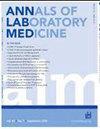低温保存对脐带血品质的影响。
IF 3.9
2区 医学
Q1 MEDICAL LABORATORY TECHNOLOGY
引用次数: 0
摘要
冷冻保存用于移植的脐带血(CB)在脐带血库储存期间偶尔会暴露在室温下。我们评估了室温暴露对冷冻保存的炭黑质量的影响。将40个冷冻CB单元储存在液氮罐中,在室温下暴露至目标温度为-130℃(第一组)、-60℃(第二组)、-40℃(第三组)或-25℃(第四组)(每组N=10),然后重新储存。再解冻后,根据细胞计数、细胞活力和集落形成单位粒细胞/巨噬细胞(CFU-GM)含量的回收率来评估冷冻CB的质量。I-IV组达到目标温度的平均曝光时间分别为0.83±0.14 min、5.92±0.88 min、10.28±1.0 min和16.0±1.62 min。IV组CD34+细胞活力明显低于其他各组(P =0.009)。各组细胞计数回收率、除CD34+细胞外的细胞活力及CFU-GM均无显著差异。在常规程序中,短期暴露在室温下,在储存期间温度升高至-40°C,不会对冷冻保存的CB的质量产生负面影响。本文章由计算机程序翻译,如有差异,请以英文原文为准。
Effect of Exposure to Room Temperature During Storage on Cryopreserved Umbilical Cord Blood Quality.
Cryopreserved umbilical cord blood (CB) for transplantation is occasionally exposed to room temperature during storage in cord blood banks. We evaluated the effect of room temperature exposure on the quality of cryopreserved CB. Forty frozen CB units stored in liquid nitrogen tanks were exposed to room temperature until they reached a target temperature of -130°C (group I), -60°C (group II), -40°C (group III), or -25°C (group IV) (N=10 in each group) and then re-stored. After re-thawing, the quality of the frozen CB was assessed based on the recovery rates of cell count, cell viability, and colony-forming unit granulocyte/macrophage (CFU-GM) content. The mean exposure times required to reach the target temperature were 0.83±0.14, 5.92±0.88, 10.28±1.0, and 16.0±1.62 mins for groups I-IV, respectively. CD34+ cell viability was significantly lower in group IV than in the other groups (P =0.009). The recovery rates of cell counts, cell viability except CD34+ cells, and CFU-GM did not significantly differ among the groups. Short-term exposure to room temperature for routine procedures and a temperature rise of up to -40°C during storage do not negatively affect the quality of cryopreserved CB.
求助全文
通过发布文献求助,成功后即可免费获取论文全文。
去求助
来源期刊

Annals of Laboratory Medicine
MEDICAL LABORATORY TECHNOLOGY-
CiteScore
8.30
自引率
12.20%
发文量
100
审稿时长
6-12 weeks
期刊介绍:
Annals of Laboratory Medicine is the official journal of Korean Society for Laboratory Medicine. The journal title has been recently changed from the Korean Journal of Laboratory Medicine (ISSN, 1598-6535) from the January issue of 2012. The JCR 2017 Impact factor of Ann Lab Med was 1.916.
 求助内容:
求助内容: 应助结果提醒方式:
应助结果提醒方式:


